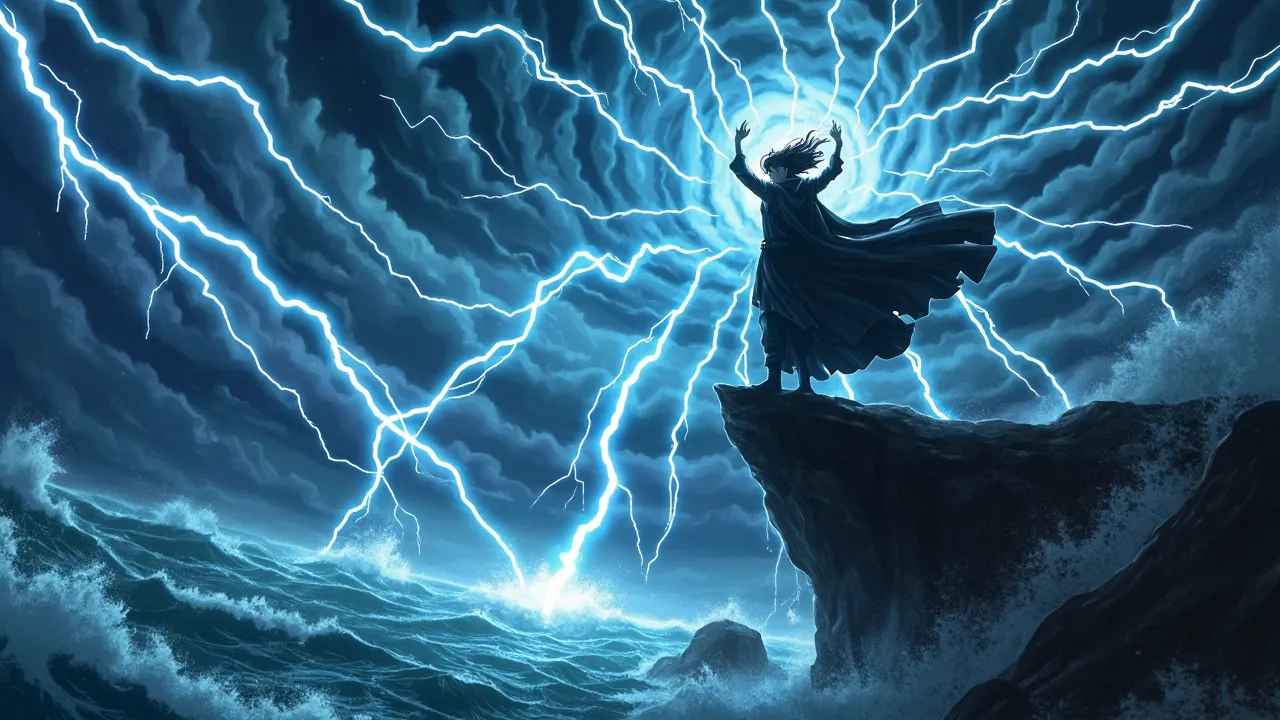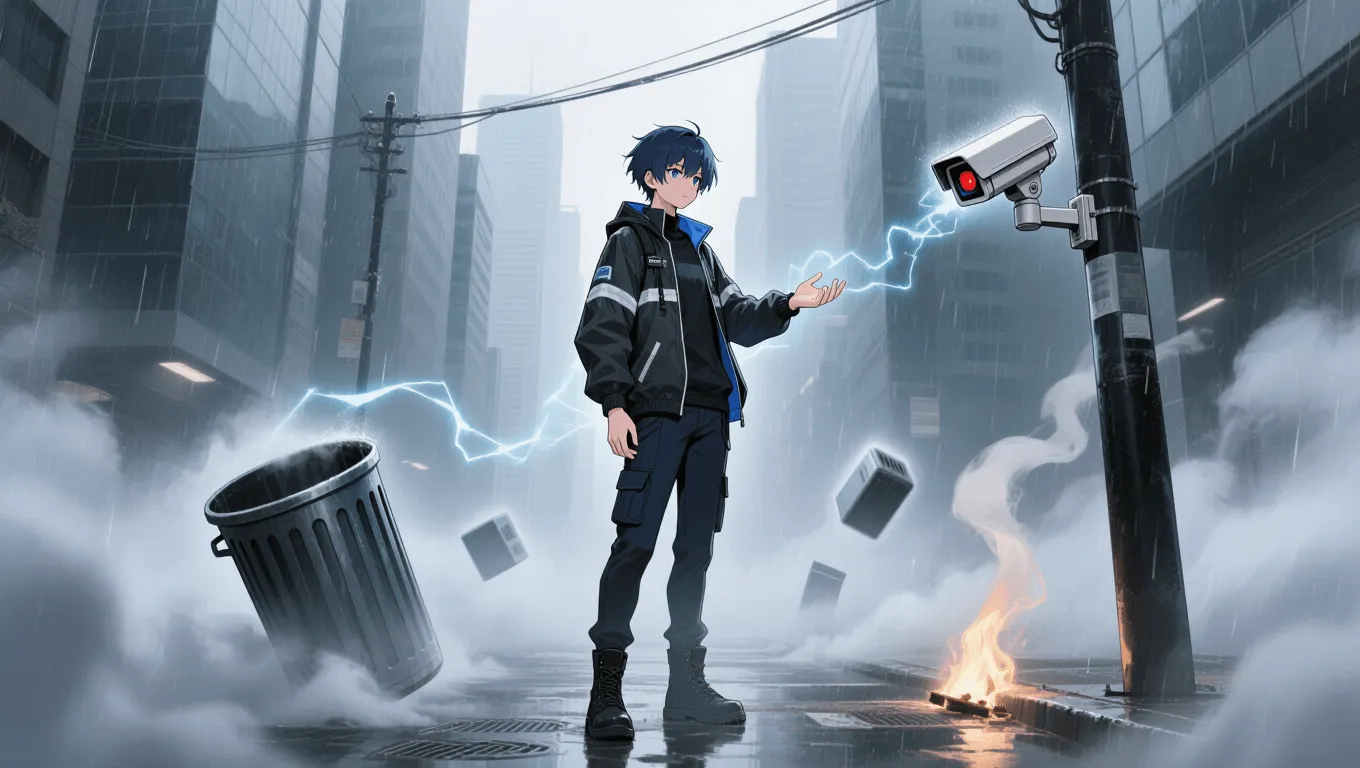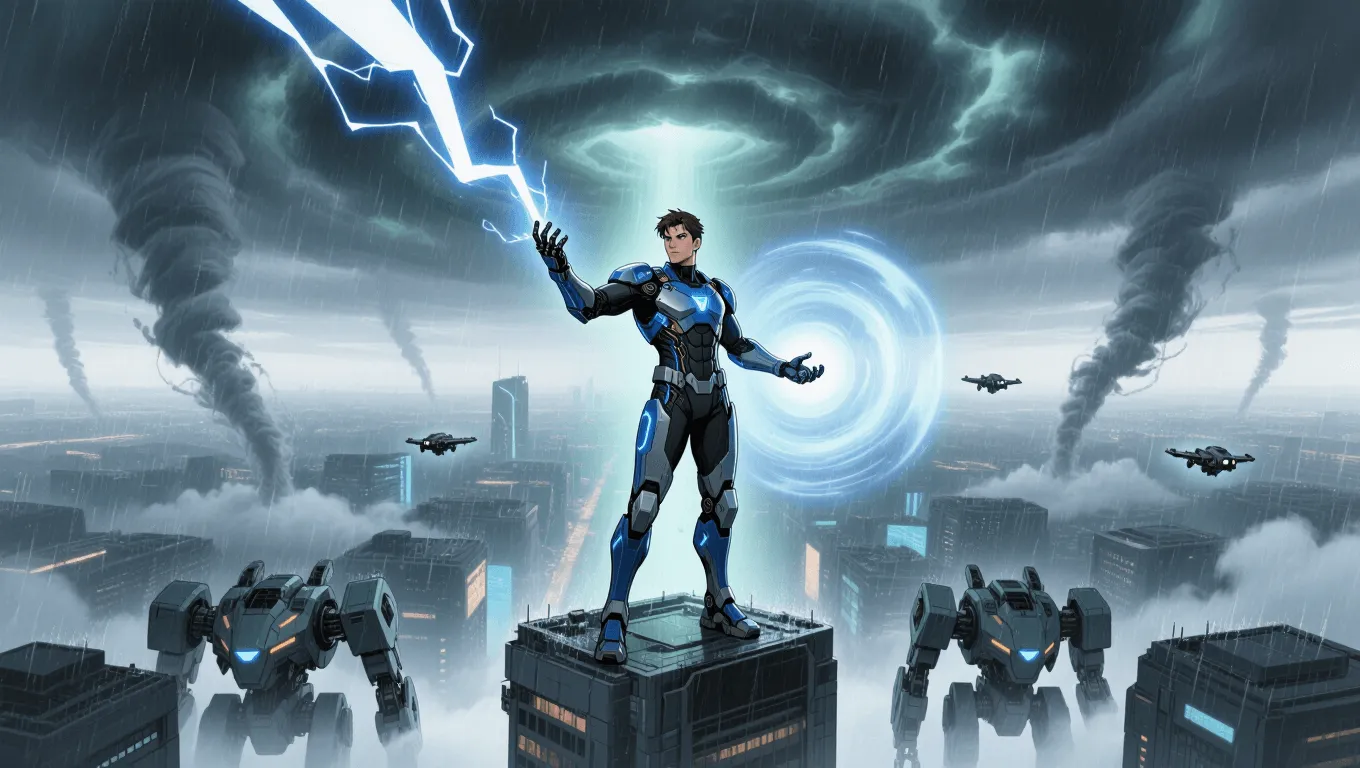Storm Manipulation | Tempestakinesis

Storm Manipulation | Tempestakinesis Video Demo 🎬
Table of Contents
- Storm Manipulation | Tempestakinesis Video Demo 🎬
- What Is Storm Manipulation
- Core abilities of Storm Manipulation
- Application / Tactical Advantages in Combat
- Level: Level 1 🏙️, Level 2 🌇, Level 3 🌃
- Limitations of using the Storm Manipulation
- Weakness against what other superpowers
- Synergistic Power Combos
- Known Users
Storm Manipulation is the power to command the sky—summoning thunderstorms, steering gale-force winds, shaping clouds, and calling down lightning with precision. Also known as tempestakinesis and often grouped under weather manipulation or atmokinesis, this superpower combines aerokinesis, hydrokinesis, electrokinesis, and thermokinesis into one devastating package. For a broader view of related abilities, browse the complete superpower wiki. If you’re brainstorming character builds or campaign ideas, try the random superpower generator to spark inspiration.
What Is Storm Manipulation
Storm Manipulation (Tempestakinesis) is the controlled alteration of atmospheric conditions to create, amplify, or disperse storms. Practitioners influence pressure systems, humidity, temperature gradients, and ionization to produce effects ranging from a light squall to a full-scale supercell. At advanced tiers, users can seed clouds, sculpt cumulonimbus towers, generate tornado-like vortices, and deliver pinpoint lightning strikes while maintaining situational awareness across a wide area.
Common related terms include weather control, thunderstorm control, hurricane creation, cyclogenesis, precipitation control, wind shear steering, fog generation, and barometric pressure manipulation.
Core abilities of Storm Manipulation
Atmospheric Sensing & Micro-Forecasting
Before shaping the sky, a storm-wielder reads it. Fine-tuned perception detects pressure changes, temperature inversions, moisture content, wind vectors, and electrical potential. This “meteorological sixth sense” enables micro-forecasting—predicting storm tracks seconds to minutes ahead—so actions remain precise and efficient.
Wind Command (Aerokinetic Vectoring)
Control over air currents permits the creation of updrafts, downdrafts, and wind shear. Users can:
-
Push or pull fronts to shift weather boundaries.
-
Generate gale-force bursts for knockback or area denial.
-
Stabilize flight paths, create cushions of air, or deflect projectiles.
Cloud & Precipitation Shaping
By clustering water vapor and orchestrating condensation, practitioners seed clouds, thicken fog for cover, and summon rain, sleet, or hail. Fog generation aids stealth; heavy rain hinders visibility, dampens flames, and softens terrain for mobility tricks.
Lightning & Ionization Control
Ionizing air channels electrical potential into controlled lightning bolts. Advanced users can:
-
Call single-target strikes with surgical accuracy.
-
Chain arcs across multiple foes using conductive surfaces.
-
“Pre-charge” an area to create a deterrent field of static.
-
Employ non-lethal stunners via low-amperage, high-voltage discharges.
Pressure Fields & Cyclogenesis
By sculpting pressure gradients, users birth localized storms:
-
Microbursts for short, explosive force.
-
Vortices resembling dust devils or waterspouts for crowd control.
-
Rotating updrafts (mesocyclones) to power severe weather when the environment permits.
Temperature Shifts
Small temperature nudges can trigger big changes—encouraging convection, melting ice to ramp runoff, or cooling air to wring out precipitation. Paired with humidity control, temperature work makes storm formation faster and more reliable.
Electromagnetic & Visibility Effects
Thunderheads can scramble radio lines, dampen drones, and interfere with targeting systems. Meanwhile, clouds, rain curtains, and lightning flash timing can mask movement, blind optical sensors, or create photonic distractions.
Terrain-Specific Patterns
-
Coastal: Cyclones and storm surges; salt spray for corrosion.
-
Desert: Haboobs (dust walls) for smothering visibility.
-
Alpine: Blizzards and whiteout conditions; ice crust hazards.
-
Urban: Updraft streets and heat island amplification; lightning routing via skyline “lightning rods.”
Application / Tactical Advantages in Combat
Area Denial & Zone Control
Rings of swirling wind, ankle-deep floodwater, and rolling thunder deter approach. Ground becomes slippery, ranged accuracy plummets, and drones falter. Users herd opponents into kill zones or away from civilians.
Burst Damage & Targeted Strikes
Lightning offers instant, line-of-sight damage with minimal travel time. Hail swarms saturate areas with blunt impacts. Microbursts knock down clustered enemies without leveling the whole block.
Mobility, Defense, and Rescue
Wind cushions reduce fall damage; tailwinds accelerate allies; rain curtains and fog provide mobile cover. Cooling arcs prevent heatstroke in long engagements. Aftermath control (draining water, parting clouds) enables quick extraction and search-and-rescue.
Counter-Tech Disruption
Electromagnetic noise degrades comms, sensors, and some guidance systems; precipitation fouls optics and clogs air intakes. Static fields can pop small electronics or force reboots at close range.
Psychological and Morale Effects
Thunder, flickering lightning, and a darkening sky can unnerve opponents while rallying allies. Well-timed thunderclaps serve as shock tactics or as synchronized cues for team maneuvers.
Non-Lethal Options
Low-amperage discharges for taser-like effects, wind walls for separation, and rain-slick surfaces for safe takedowns allow escalation control in crowd scenarios.
Level: Level 1 🏙️, Level 2 🌇, Level 3 🌃
Level 1 — Weather Adept
-
Scope: Room to city block. Short bursts: gusts, light rain, localized fog, static shocks.
-
Control: Can deflect thrown objects, blind cameras with fog, dampen flames, or stun a single foe.
-
Limitations: Dependent on existing conditions; lightning is rare and low-power; sustained effects cause fatigue.

Level 2 — Stormcaller
-
Scope: Several city blocks to a small district. Can seed clouds, summon thunderstorms under favorable conditions, and guide lightning with fair precision.
-
Control: Maintains concurrent effects—wind walls plus rainfall, or fog with intermittent lightning. Launches microbursts and limited hail.
-
Tactics: Establishes area denial, disrupts tech, and performs fast battlefield reshaping.
-
Limitations: Collateral risk rises; needs moisture and temperature differentials; concentration split between multiple phenomena.

Level 3 — Tempest Sovereign
-
Scope: City-scale cells under optimal weather; can steer fronts and create severe events (supercell behaviors, tornadic vortices) if the environment supports it.
-
Control: Pinpoint lightning while sustaining wide-area rain bands and pressure walls. Can intentionally open “eyes” of calm inside storms for ally operations.
-
Tactics: Dominates airspace, cripples large mechanized units, and stages strategic weather corridors for weeks-long campaigns (with rest and favorable climate).
-
Limitations: Massive stamina drain; catastrophic collateral if misjudged; long spin-up times for the largest systems; ethical and environmental consequences.

Limitations of using the Storm Manipulation
-
Environmental Dependence: Humidity, temperature gradients, and available particulates influence storm formation speed and strength. Arid, stable air limits options.
-
Inertia & Lead Time: Full storms require minutes to hours; rapid micro-effects are possible, but mega-systems still obey physics.
-
Precision vs. Scale Trade-off: The wider the storm, the harder it is to land surgical lightning or maintain safe lanes for allies.
-
Stamina and Focus: Managing multiple weather variables is cognitively brutal. Overexertion can cause rebound effects—uncontrolled squalls or lightnings misfiring.
-
Collateral & Friendly Fire: Flooding, ice, and falling debris endanger non-combatants; lightning conducts unpredictably through metal.
-
Line-of-Sight & Altitude: Directing cloud architecture is easier with sky visibility; subterranean or enclosed spaces reduce effectiveness.
-
Urban Interference: Concrete can alter thermals; skyscrapers redirect winds and can unpredictably channel lightning.
Weakness against what other superpowers
-
Vacuum or Space Manipulation: Removing the medium (air) nullifies wind, sound, and classic storm dynamics.
-
Thermokinesis (Heat/Cold Mastery): Flattening temperature gradients kills convection, dispersing clouds and stalling storm growth.
-
Gravity Manipulation: Stabilizing or reorienting air masses disrupts updrafts and prevents cyclogenesis or tornado formation.
-
High-Tier Aerokinesis (Specialist Duel): A dedicated wind controller can shear apart a storm-user’s structures or redirect them.
-
Electromagnetic Shielding & Insulation: Faraday-like barriers, grounded armor, and conductive cages blunt lightning strikes.
-
Energy Absorption/Redirection: Electrical absorbers turn lightning into fuel or route it harmlessly to ground.
-
Force Fields & Hard Barriers: Physical domes resist wind, hail, and debris; storms lose bite without exposed surfaces.
-
Environmental Immunity: Characters immune to cold, wet, or pressure ignore most secondary storm effects.
-
Geokinesis (Shelter & Grounding): Rapid earthworks create trenches, berms, or stone canopies and offer safe lightning pathways.
Synergistic Power Combos
Aerokinesis + Hydrokinesis = Cyclone Engineering
Dedicated wind shaping plus water control accelerates cloud formation, intensifies rainfall, and refines storm tracks with surgical sharpness.
Electrokinesis + Magnetism = Precision Thunder
Magnetic field shaping guides current flow, enabling ricochet arcs, EMP-style pulses, and safe “umbilicals” that won’t backflash into allies.
Cryokinesis + Fogcraft = Whiteout Control
Rapid cooling thickens fog to opaque curtains or drops sleet and rime ice for movement denial and vehicle immobilization.
Technopathy + Sensor Mesh = Smart Storms
Networked drones and IoT weather nodes feed real-time data. The user micro-adjusts pressure and humidity to maintain optimal power while minimizing collateral.
Geokinesis + Barriers = Debris-Safe Tempests
Wind walls pair with earth berms to catch hail and shrapnel, protecting civilians while maintaining pressure advantages.
Illusion Casting + Thunder Timing = Shock Tactics
Thunderclaps mask movement and spellcasting queues; lightning flash syncs with visual illusions to overload enemy perception.
Teleportation + Storm Steps = Instant Positioning
Users blink between updraft columns and cloud gaps, appearing where visibility is lowest and escape vectors are strongest.
Known Users
-
Storm (Ororo Munroe), X-Men — A premier comic example of refined storm control, tactical restraint, and global-scale feats. Learn more on her Marvel profile.
-
Thor (Marvel Comics) — Wields Mjölnir to command thunder and tempests as both weapon and symbol of divine authority. See the Thor character page.
-
Weather Wizard (DC Comics) — A villain known for high-tech assisted weather control and targeted storm crimes. Read about him on DC’s character hub.
For more powers adjacent to stormcraft—from pure aerokinesis to full weather manipulation—explore the categorized entries in our superpower wiki, and if you want fresh character concepts, spin the random superpower generator to discover unexpected combos.
